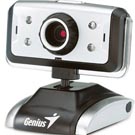Don't get distracted by megapixels in search for right webcam
 Dusseldorf - Whether you want to chat with friends or send video greetings, a webcam is what you need to quickly turn your computer into a video telephone.
Dusseldorf - Whether you want to chat with friends or send video greetings, a webcam is what you need to quickly turn your computer into a video telephone.
There's a huge variety to choose from, so when it comes time to buy the one that's right for you, it's best not to get distracted by numbers games. It's easy to get lost in advertising copy about eight megapixels, or transmission rates of 90 images a second.
"It's mainly massaging numbers," says Nam Kha Pham, a webcam expert with the German computer magazine PC Praxis.
Thus, any search should focus on picture and sound quality.
Robert Globisch of German online merchant computeruniverse. net agrees, noting that webcams now tout their megapixels the way makers of digital cameras once did "without actually stating that this has any relation to image quality."
Extremely high megapixel counts only really matter with still photography. It's seldom that these high resolutions are realized when chatting via the net.
"Most chat programs reach their limits with a resolution of 640 by 480 pixels, or 0.3 megapixels," says Nam Kha Pham. "And only a very few households have a fast enough connection to allow full-image high-definition telephony."
In a best-case scenario, truly high rates are possible with a display the size of an average mobile phone screen.
But those rates aren't even necessary. "Twenty to 30 images per second are enough to make for streaming video telephony," says Nam Kha Phan. Even older computers and netbooks should be able to handle that. Thus, customers needn't bother with cameras advertising 1.3 to 2 megapixels.
Picture and sound quality are what count. So does ease of use. It's no longer necessary to spend a lot of money for a decent webcam. Household names like Logitech, Microsoft and Philips offer starter models.
"You can get a light-intensive camera with good sound for 20 to 50 euros (28 to 70 dollars)," says Globisch. Nam Kha Pham adds that buyers don't have to give up on extras like auto-focus or facial tracking with mid-priced models.
The lens is key. To be on the safe side, look for products from Carl Zeiss or Schneider Kreuznach, the kind of lenses used in high-end cameras. The lens should be able to function in both uneven and poor lighting. A well-integrated microphone that filters out background noise is also important.
The QuickCam Pro 9000 from Logitech, which costs around 60 euros, won top honours in the PC Praxis March 2009 edition thanks to its sensible lighting technology. Next came Microsoft's LifeCam Show NX-8000, at around 45 euros, which scored well thanks to its high quality sound.
The Genius iSlim 2000AFund, at about 35 euros, was considered to have the best cost-performance ratio.
Stiftung Warentest, a German consumer products reviewer, recommends the Minoru 3D Webcam from Novo for people who want to try something different. Costing about
80 euros, it's the first cheap and simple solution for three-dimensional video telephony.
A programme calculates a 3D space based on the images received from two cameras mounted in the computer. Users use special 3-D glasses to get the full sensation. So far, the camera has functioned fine in tests.
"From a technological standpoint, some of the colour gets washed out and the glasses are uncomfortable," notes tester Marcus Pritsch. (dpa)